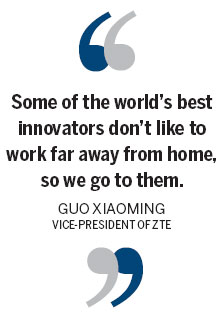Talent grows wings
Updated: 2013-07-12 08:43
By Meng Jing (China Daily)
|
|||||||||||

Chinese companies are expanding their R&D capabilities far and wide
It is well known in the high-tech world that Chinese networking major Huawei Technologies Co Ltd has one of the best set of engineers in the country.
The Shenzhen-based telecom equipment supplier has more than half of its total employees working on research and development. Its R&D center in Shanghai alone, a large building stretching over half a kilometer, has more than 10,000 engineers working on various telecom technologies.
Despite its rich pool of research talent, Huawei is still on the lookout for more world-class researchers and innovators. The company announced on July 2 that it plans to join hands with the Imperial College London, one of the top-10 universities in the world, to develop the next-generation big data technologies.
The two sides have signed a memorandum of understanding to develop a joint center for business experts and researchers to develop innovations and applications in digital, energy, healthcare, future cities and life sciences areas.
Though the agreement will be valid for a year, during which the two sides plan to flesh out the details of the proposed center, William Xu, chief executive of the enterprise business group with Huawei, says he is "looking forward to working with the university over the next 12 months and beyond".
"Imperial is one of the world's great universities. We intend for this agreement to lead to a significant partnership in London and to reinforce our commitment to the UK. R&D has always been a top priority for Huawei, and this continues to be the case as we expand our UK operations."
Huawei is not alone in expanding its R&D talent base. Several Chinese companies are expanding their businesses to overseas markets, and an increasing number plan to broaden their R&D facilities outside China if they have not already done so.
The investment on overseas R&D centers has increasingly become a highlight of China's outbound direct investment, says Chen Runyun, commercial counselor at the department of outward investment and economic cooperation at the Ministry of Commerce.
Chen says China's outbound direct investment increased to $74.6 billion (58.16 billion euros) in 2011. Along with this, Chinese companies' overseas investment focus has shifted from catering business and tourism to more and more R&D centers and sales networks.
According to the 2012 China Innovation Survey conducted by the Benelux Chamber of Commerce, Wenzhou Chamber of Commerce, CEIBS and Booz & Co, more than 70 percent of the 100 surveyed Chinese companies are planning to expand their R&D facilities in overseas markets in the next 10 years.
Nearly 53 percent of the Chinese companies expressed keenness to team up with foreign partners to enhance R&D skills, while a large minority, 40 percent, envisaged setting up their own R&D operations.
Steven Veldhoen, partner of Booz & Co, a global management-consulting firm, says that though Chinese companies' global expansion in R&D is still at an early stage, a lot has been going on because the expansion is often in different forms.
"Companies can establish their own overseas R&D centers, set up partnership with universities and research institutes, and also gain technologies through acquisitions," says Veldhoen, adding that Chinese companies are going out for the same reason that multinational companies are going to China.
Market access, understanding the customers and suppliers in the local markets and gaining access to specific technologies are the prime motivators, he says.
China's ZTE Corp, a leading global provider of telecommunications equipment and network solutions, has 18 R&D facilities around the world. Guo Xiaoming, vice-president of ZTE, says that by setting up local R&D centers in other countries, the company has been able to take advantage of each country's particular talents and technologies.
"Some of the world's best innovators don't like to work far away from home, so we go to them," Guo says, adding that the company's generous investment on R&D and the utilization of its global talent network are the main reasons for ZTE being one of the leading patent applicants last year.
George Yip, co-director of the CEIBS Centre on China Innovation, says many other countries are still at the forefront certain technologies and it makes a lot of sense for Chinese companies to go there and learn these technologies and then bring them back to China.
"The difference is that about 100 percent of Apple's products are at the top level, while 10 percent of Huawei or TCL's products are at the same level as Apple."
Though there have been doubts as to whether China's R&D expansion to other countries would create more competition between Chinese companies and those from other countries, experts say there is no cause for concern. Dan Steinbock, research director of International Business at the India, China and America Institute, an independent think tank in the US, says such fears are unwarranted.
These days multinational leaders compete by dispersing their production capacity geographically and by disintegrating their value activities into networks, he says. As a result, every innovation leader, from GE to Huawei, has production, sales, R&D and design in multiple locations and multiple value activities worldwide.
"It doesn't matter whether it is a Chinese company or a non-Chinese company. Talent moves among companies. In the global innovation game, one country's win can be another country's gain. As humanity, we stand or fall together."
mengjing@chinadaily.com.cn
( China Daily European Weekly 07/12/2013 page7)
Today's Top News
List of approved GM food clarified
ID checks for express deliveries in Guangdong
Govt to expand elderly care
University asks freshmen to sign suicide disclaimer
Tibet gears up for new climbing season
Media asked to promote Sino-Indian ties
Shots fired at Washington Navy Yard
Minimum growth rate set at 7%
Hot Topics
Lunar probe , China growth forecasts, Emission rules get tougher, China seen through 'colored lens', International board,
Editor's Picks

|

|

|

|

|

|





